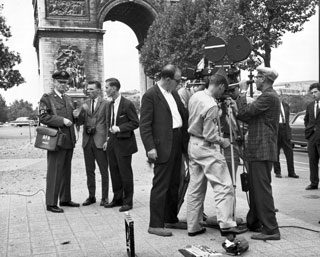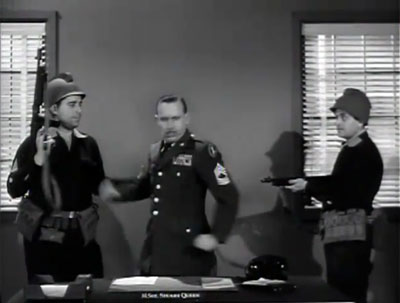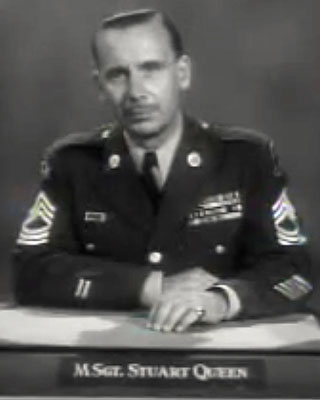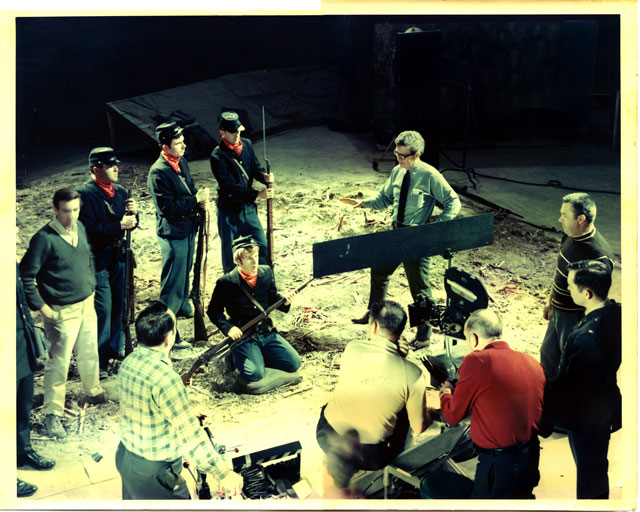 |
|||
|
The Big Picture
"The Big Picture" was the Army's ground-breaking television series. The half-hour weekly program featured famous or before-they-were-famous actors and actresses in top quality productions, filmed on the Astoria stages. In the 1950s the series was shot on 35mm black-and-white negative, but by the end of the 1960s, it was using 16mm color negative. The series covered a wide range of subjects, telling the Army's story in history and in current events. The Big Picture on DVD The Pentagon Channel airs many of the Big Picture films as part of their "Battleground" series that airs daily at 2:30am, 7am, 3pm & 11pm (eastern). Anyone that does not receive The Pentagon Channel from their cable or satellite provider can watch a live stream of the channel 24/7 at www.pentagonchannel.mil just click on "watch live" in the upper right hand corner to view the channel. While The Pentagon Channel does not distribute dvds or tapes of their programming to the public, it is a good way for anyone to view the episodes for free. The episodes are also becoming available via itunes for no charge. (05/01/2020)The Big Picture online On location
Episodes about the Battle of the Bulge Douglas Powell wrote, "I served in the US Army Corps of Engineers, 11th Engineer Group, in West Germany during the period from August 1963 to June 1965. I was a helicopter pilot flying our of Heidelberg, Germany. A Signal Corps aviation unit was also located at that airport. Once, I was requested to fly co-pilot in a H-34 helicopter carrying the film crew for 'The Big Picture.' Filming was being done to tell the story of the Battle of the Bulge. We flew the area around Bastogne and landed in St. Vith, Belgium. But I never saw the finished film. I was sharing the story with my grandchildren and decided to see if I could obtain anywhere a video, such as a DVD, containing that story I helped film. Can you help?" There are three titles listed in The Big Picture catalog:
Many of these title have been converted to video and can be found online.
Hall of Heroes was an episode of The Big Picture featuring the Medal of Honor and the soldiers who earned this highest award. Lt. Richard A. Jones provided a photo with narrator John Daly and a note about this production.
TV host detained Master Sergeant Stuart Queen is detained and escorted from the set of The Big Picture in an episode of the Army's weekly television program dramatizing the Army's war gaming. Peter Anderson asked, "I vaguely remember the host of 'The Big Picture' being escorted from the set by military or Pentagon police, and the episode going to commercials. Did this occur, and when and to whom if it did occur?" Stephen Brittenham of Albuquerque supplied the answer, with a link to YouTube. "I think this may be what he is referring to: http://www.youtube.com/watch?v=Eczdl5pBiFg&feature=related." This episode, "The Aggressor," appears twice in The Big Picture catalog at TV 362 and TV 555. The drama puzzles contemporary viewers, who are unfamiliar with the TV series, but it was exciting action when the show aired in the 1950s. MSG Carl Mueller, USA (Ret.), wrote, "In 2005, I asked about episodes of The Big Picture that featured the Army Language School and its successor, the Defense Language Institute. Through the information you provided, I was able to locate all four episodes. "The first three episodes (TV-200, TV-492 and TV-585) have been available commercially through amazon.com since late-April 2008, along with over 340 other episodes of The Big Picture. In 2007, a division of amazon.com called CreateSpace entered into an agreement with the National Archives and Records Administration to digitize many of the films in the archives. Although not in the National Archives, I was able to obtain a DVD of the fourth episode (TV-779) through other channels. "The episode I was most interested in was "Special Forces Advisor" (TV-585), which ultimately led me into a 20-year career as an Army linguist. I've been able to contact Paul Wineman, the Special Forces officer that starred in this episode. He's informed me that there was a sequel to this episode, entitled "Special Forces Advisor - Part 2." It was shot in 1964 and released in 1965. "Do you know anything about this episode (TV-#, location, etc.)? If there's a reference copy at the National Archives, CreateSpace would be able to release a DVD. Any information would be greatly appreciated." (Posted June 12, 2008)
Kent Hughes wrote, "I couldn't find Master Sergeant Stewart Queen on your list for APC, The Big Picture site. I remember him as the narrator of The Big Picture. It's been a long time so I may be off with the name. He was a master sergeant with a thin mustache and a South West Pacific GHQ patch. I would really like to know about him because as a kid I really looked forward to his introductions to The Big Picture. Any information would be appreciated." Kent Hughes, aggieblue75@yahoo.com (Posted January 6, 2006) Weaned on The Big Picture: Lieutenant Colonel (Retired) Paul Schaum wrote, "The old program that I was weaned on as a kid on the Lower East Side probably had a great impact upon me. It would be great if someone could get at least some of these shows on DVD for some of us old 'Lifers.' Despite being a disabled veteran, I still believe in what we did and continue doing. Thanks for the web site!" Episodes of The Big Picture occasionally turn up through online video suppliers. A web search using "The Big Picture," Army and VHS will probably find you some titles. Many episodes of The Big Picture are stored in the National Archives in College Park, Maryland. The films are public and -- if a master tape has been made -- can be copied (bring your own blank tape.) The films themselves are also available for transfer to a master video by anyone who will pay for the transfer.
This is a production still from the 1971 Big Picture, TV-803, "Hall of Heroes," about the Pentagon's Medal of Honor display, describing the bravery of the men named in the Hall of Heroes and dedicated to those who have won the Medal of Honor. This was one of the last Big Picture episodes made at APC. (The last episode listed in the Big Picture series was episode number 823.) For this scene about a Civil War soldier whose battlefield actions earned him the famous award, APC had acquired stock footage. The stock footage wide shot featured troops moving through a cornfield. This stage setup, on the main stage at APC, matched the trampled cornfield. In this shot, the soldier at center runs into the scene and drops to his knees (on the out-of-camera cushion) while he reloads his rifle. In this tight shot, the camera catches glimpses of other troops running past. In fact, the "other troops" were the three soldiers at upper left, who were actually lieutenants stationed at APC and who happened to be available for this shot on this day. The young soldier in the closeup was portrayed by a New York actor hired for this scene. The middle of the three standing Civil War soldiers is Second Lieutenant Clarence Kugler. Standing at far right is First Lieutenant Robert Perkins. (If you can identify others in the photos, e-mail Webmeister.) (Posted November 21, 2005)
The Big Picture featured the Army's Language School, now Defense Language Institute, in four different episodes. Carl Mueller, MSG USA (Ret.), asked, "I'm looking for an episode of The Big Picture that featured the Army Language School (or possibly its successor, the Defense Language Institute). My brother and I saw it as kids, and when I graduated from college with a major in German and a minor in French, my brother suggested I join the Army and pick up another language. Two languages and 20 years later, I retired as a Master Sergeant, having completed a very fulfilling military career. I'd love to see the film that started it all for me." The Army Language School / Defense Language Institute (which is still very much in operation in Monterey, California,) was featured in four different episodes of The Big Picture listed below. The first three of these exist as reference copies in the National Archives. The first Big Picture episode about the Monterey institute was "The Army Language School" from the 1952-1953 season. It was declared Obsolete in Army files, with the explanation, “The following films have been declared obsolete and are not available for showings. There obsolete film are marked with an asterlsk (*) in the Master Title List and also in the detailed listing of synopses. Each year the listing of new episodes of THE BIG PICTURE also will contain any additional films which have been declared obsolete.” Episodes of The Big Picture featuring the Army’s language school were: TV-200 Army Language School (Released in the 1952-1953 season.) A look at Language School in Monterey and teaching methods and facilities. (This film has been marked Obsolete. There is a reference copy of this film in the National Archives and Records Administration in College Park, Maryland.) TV-492 U. S. Army Language School (Released in the 1960-1961 season.) The story of the U.S. Army Language School and the training program provides officer and enlisted personnel in. meeting Army requirements in learning a foreign language. (There is a reference copy of this film in the National Archives and Records Administration in College Park, Maryland.) TV-585 Special Forces Advisor (Released in the 1962-1963 season.) A Special Forces Officer trains for duty in the Near East. Film follows training at Fort Bragg and Army Language School at Monterey, California, then to Iran. (There is a reference copy of this film in the National Archives and Records Administration in College Park, Maryland.) TV-779 Language Power For Peace (Color-28 min-1970) Documents the imaginative approaches used by the defense language institute to the task of teaching servicemen fifty different foreign languages. (No reference copy available in the National Archives.)
The last episode? -- The Television Division of Army Pictorial Center "produced the very last episode of the Big Picture, the only one using television instead of film"in 1961, wrote Barry Flynn. Barry may be remembering the last episode of a season, but it certainly wasn't the last Big Picture. According to a catalog of Big Picture episodes in the National Archives, the last release was TV 823, "Drill Sergeant," released in 1971: "Focuses on one Army drill sergeant as he goes about his daily duties of shaping and molding young civilians into soldiers," color, 28 minutes.
There apparently weren't 823 episodes of The Big Picture, but the count was pretty close. According to the catalogue of films, a few numbers in the series "TV ###" weren't used. Some topics and titles were evergreen, being featured in several episodes of The Big Picture over the years, like the episodes about the Army Language School described above. When titles or topics were repeated, the productions were entirely new, and, except for library footage of dated events, new footage was shot. The Big Picture survived Army Pictorial Center, but just barely. The studio closed in 1970, and the remaining films into 1971 were finished at Redstone Arsenal.
From the web
site TV ACRES at
http://www.tvacres.com/begin_military.htm: Saul Frisch directed several Big Picture episodes as Larry Frisch during a long career that often found him at Army Pictorial Center. Albert V. Spratley wrote: "My father worked at the APC from 1955 thru 1960. During that time he wrote for the Big Picture, and also played several roles in some of the films. Is there a library or resource that is available to find some of these old films? I would like to get some copies if possible. His name was MSGT Albert W. Spratley. Thanks for any help. ALBERT.V.SPRATLEY@saic.com, SCIENCE APPLICATIONS INTERNATIONAL CORPORATION, (256) 971-6494 (VOICE), (256) 971-7314 (FAX)." "In 1953/1954 I served as a motion picture cameraman with the 497th Signal Photo Company in Kaiserslautern, Germany," writes Jim O'Donnell. "While there my assignment was to supply motion picture footage for use in an Army syndicted television show called 'The Big Picture.' On one particular assignment I filmed a story called. 'The Battlegrounds of World War II' which was edited into a half hour episode of 'The Big Picture.' Question: Is there an archive of these shows in existence anywhere? I would enjoy seeing that show again as I have many pleasant memories associated with the completion of this project. My name is James O'Donnell. My service number was: US 52 277 276. My e-mail address is NTNJIM@aol.com I'd appreciate a response to this query. Thanks. Jim O'Donnell" Michael
L. Denn wrote, "Growing up I remember watching “The Big Picture” TV
program about World War II with my father, a WWII veteran. Is there any
place that videos or DVDs of these programs can be purchased?
Can anyone provide information about The Big Picture episode "Beach Head"? Does anyone have information about APC director Andrew T. Kelley? Herbert Maison seeks pictures of William O. Woolridge. These and other questions are asked on our Help Requested page. One answer: TV-579 The Big Picture-Beachhead: Anzio (B&W-28 (B&W-28 min. 1963) Documents the establishment of an allied beachhead at Anzio in World War 11. Features footage not previously viewed by the public.
The Big Picture is the topic of another query: "I am looking for The Big Picture series that was filmed at Fort McNair, Washington D.C. 1962 or 63 of A-Co 3rd Infantry "Old Guard" doing Prelude to Taps.I particapated in this film. I can be reached at Montie Wagner wanmon@comcast.net, Ph:(423) 954-9073." The answer: This episode of The Big Picture must have been a good one, because apparently the Army released it three different times: TV-533 (1961-1962 season) Filmed at Washington,. D.C ., the Army's "Old Guard" - the 3rd Infantry Regiment - combines with the U.S. Army Band to present its annual pageant of military skills and traditions. (Reference copy available in the National Archives and Records Administration in College Park, Maryland.) TV-597 The Big Picture - Prelude to Taps (Color-28 min-1964) Tribute to American soldier in the form of Army drills, ceremonial and pageant as performed by 3d US Infantry at Ft. McNair, Washington, D.C. The famed 3rd Infantry, "The Old Guard", in the Nation's capital, offers a colorful, marching salute to all members of the Army team. Shown is a retreat review, a salute to flags of states and country, rifle drill and the marching precision of the Honor Guard drill team. (No reference copy available in the National Archives.) TV-788 The Big Picture - Prelude to Taps (Color-28 min-1971) Members of the "Old Guard" 3rd Infantry perform drills and tableaus to dramatize the role of the US Army in the growth of our country. (No reference copy available in the National Archives.) (Updated June 4, 2005.)
Page updated June 10, 2019.
|
|||















